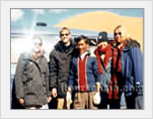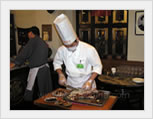
Suzhou Museum Guide
-Travel to Suzhou Museum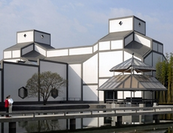 The new Suzhou Museum designed by I.M. Pei Architect with Pei Partnership Architects is located in the northeast section of the historic quarter of Suzhou. It adjoins the landmarked Zhong Wang Fu, a complex of 19th-century historical structures, and the Garden of the Humble Administrator, a 16th-century garden listed as a UNESCO World Heritage site. Founded in 1960 and originally located in the national historiclandmark, Zhong Wang Fu palace complex, Suzhou Museum has been ahighly-regarded regional museum with a number of significantChinese cultural relics. A new museum designed by world famousarchitect I.M.Pei was completed in October 2006, covering over10,700 square meter and located at the cross of Dongbei Street andQimen Road. The design of this new museum visually complements thetraditional architecture of Zhong Wang Fu. The new museum housesover 30000 cultural relics --- most notably for excavatedartifacts, Ming and Qing Dynasty paintings and calligraphy, andancient arts and crafts.
The new Suzhou Museum designed by I.M. Pei Architect with Pei Partnership Architects is located in the northeast section of the historic quarter of Suzhou. It adjoins the landmarked Zhong Wang Fu, a complex of 19th-century historical structures, and the Garden of the Humble Administrator, a 16th-century garden listed as a UNESCO World Heritage site. Founded in 1960 and originally located in the national historiclandmark, Zhong Wang Fu palace complex, Suzhou Museum has been ahighly-regarded regional museum with a number of significantChinese cultural relics. A new museum designed by world famousarchitect I.M.Pei was completed in October 2006, covering over10,700 square meter and located at the cross of Dongbei Street andQimen Road. The design of this new museum visually complements thetraditional architecture of Zhong Wang Fu. The new museum housesover 30000 cultural relics --- most notably for excavatedartifacts, Ming and Qing Dynasty paintings and calligraphy, andancient arts and crafts.
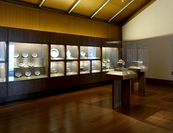 Suzhou was the artistic center of China in the Ming period – 15th to 16th centuries – and most of the famous artists of the time were natives of Suzhou. The museum opened its galleries for painting and calligraphy with a special display of works by the so-called Four Ming Masters (all from Suzhou), combining the museum’s own holdings with loans from the Shanghai Museum. The antiquities are mainly bronzes and jades from archaeological excavations of Neolithic (jades from ~2,500 B.C.) and Bronze Age sites (mainly bronzes and jades c.500 B.C.) around Suzhou. The design of the museum takes its cues from the rich vocabulary of Suzhou’s traditional architecture, with its whitewashed plaster walls, dark grey clay tile roofs and intricate garden architecture. However these basic elements have been reinterpreted and synthesized into a new language and order, one that is contemporary and forward looking and hopefully one that is a possible direction for the future of Chinese modern architecture.
Suzhou was the artistic center of China in the Ming period – 15th to 16th centuries – and most of the famous artists of the time were natives of Suzhou. The museum opened its galleries for painting and calligraphy with a special display of works by the so-called Four Ming Masters (all from Suzhou), combining the museum’s own holdings with loans from the Shanghai Museum. The antiquities are mainly bronzes and jades from archaeological excavations of Neolithic (jades from ~2,500 B.C.) and Bronze Age sites (mainly bronzes and jades c.500 B.C.) around Suzhou. The design of the museum takes its cues from the rich vocabulary of Suzhou’s traditional architecture, with its whitewashed plaster walls, dark grey clay tile roofs and intricate garden architecture. However these basic elements have been reinterpreted and synthesized into a new language and order, one that is contemporary and forward looking and hopefully one that is a possible direction for the future of Chinese modern architecture.
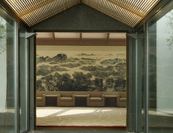 As with traditional Suzhou architecture, the design of the Art Museum is organized around a series of gardens and courts that mediates between the building and its surrounding environment. The main Museum Garden is a contemporary extension and commentary of the Garden of the Humble Administrator to the north. As visual connections between the two properties are not possible due to the high garden walls, water is used physically and metaphorically as a bridge between the two properties. The landscape design of the new Museum Garden and its smaller Gallery and Administrative Gardens is not based on traditional and conventional approaches. Rather, new design directions and themes were sought for each of them, where the essence of traditional landscape design can be distilled and reformulated into potentially new directions for Chinese garden architecture.
As with traditional Suzhou architecture, the design of the Art Museum is organized around a series of gardens and courts that mediates between the building and its surrounding environment. The main Museum Garden is a contemporary extension and commentary of the Garden of the Humble Administrator to the north. As visual connections between the two properties are not possible due to the high garden walls, water is used physically and metaphorically as a bridge between the two properties. The landscape design of the new Museum Garden and its smaller Gallery and Administrative Gardens is not based on traditional and conventional approaches. Rather, new design directions and themes were sought for each of them, where the essence of traditional landscape design can be distilled and reformulated into potentially new directions for Chinese garden architecture.
More Attractions in Suzhou
- Water Town Tongli
- The Lingering Garden
- The Ancient Grand Canal
- The Master of Nets Garden
- Silk Embroidery Factory
- Tiger Hill
- Xuanmiao Taoist Temple
- Panmen Scenic Zone
- Shiquan Culture Street
- Zhouzhuang town
- Mountain Villa with Embracing Beauty
- The Garden of Cultivation
- Lingering Garden
- Suzhou Museum
- Lion Grove Garden
- Hanshan Temple
- Jinji Lake
- Shantang Street
Your Question & Quick Answer*We welcome and appreciate your questions & reviews
Booking Procedures | Terms & Conditions | Payment Methods | Links | Site Map | About Us | Contact Us | Travel Agent
Copyright 2008, All rights reserved.. itourbeijing.com professional china travel guide and china travel service
TEL: 86-10-85711972 (Universal) 1-888-288-9328 (North America) E-mail: contact@itourbeijng.com
Tours Index | China Tours | Beijing Tours | Xi'an Tours | Shanghai Tours | Guilin Tours | Tibet Tours
China Travel | Beijing Travel | Shanghai Travel | Xi'an Travel | Guilin Travel |Beijing Map
China Golf | Beijing Golf | Shanghai Golf | Xiamen Golf | The Great Wall Travel | Yangtze Cruise | Travel Picture
